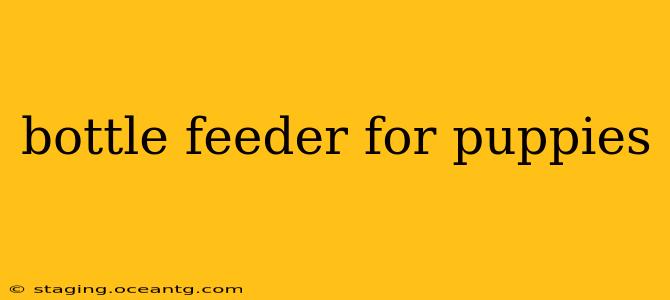Welcoming a newborn puppy into your life is incredibly rewarding, but it also comes with responsibilities, especially if the pup requires bottle feeding. Whether you're fostering an orphaned puppy or your dog's litter needs supplemental feeding, understanding the intricacies of bottle feeding is crucial for their health and development. This guide provides a comprehensive overview, answering many common questions new puppy owners have.
What kind of bottle is best for feeding puppies?
Selecting the right bottle is the first step to successful puppy bottle feeding. You'll want a bottle designed specifically for puppies, featuring a slow-flow nipple to prevent choking and ensure the puppy can comfortably latch and feed. Avoid using human baby bottles, as the nipples are often too fast-flowing for a puppy's delicate system. Look for bottles with a variety of nipple sizes, as your puppy's needs will change as they grow. Many pet stores offer a range of options; some even mimic a mother dog's nipple more closely.
What kind of formula should I use for bottle-feeding puppies?
Using the correct formula is paramount. Never use cow's milk. Cow's milk lacks the essential nutrients puppies need and can cause digestive upset, diarrhea, and even death. Instead, opt for a commercially available puppy milk replacer (PMR). These formulas are specifically designed to meet the nutritional needs of puppies, providing the necessary proteins, fats, vitamins, and minerals for healthy growth. Always follow the instructions on the package for mixing ratios to ensure proper nutrition.
How often should I feed a newborn puppy?
The feeding frequency depends on the puppy's age and size. Very young, newborn puppies (under two weeks old) may need to be fed every 2-4 hours, around the clock. As they grow, the intervals can gradually increase, and the quantity of formula can also increase. Observe your puppy for signs of hunger; they may whine, paw at you, or root around.
How much formula should I give my puppy per feeding?
The amount of formula depends on the puppy's weight and age. Consult your veterinarian or the instructions on the puppy milk replacer package for appropriate feeding amounts. Overfeeding can be just as harmful as underfeeding. You should also monitor your puppy's weight to adjust feeding amounts as needed.
How do I know if my puppy is getting enough to eat?
Several indicators demonstrate whether your puppy is receiving adequate nutrition. A healthy puppy will gain weight steadily, have firm stools, and exhibit active behavior. Keep a close eye on their bowel movements and weight; any significant changes should prompt veterinary consultation. If your puppy seems lethargic, weak, or isn't gaining weight, consult your vet immediately.
What temperature should the puppy formula be?
The formula should be prepared according to the package instructions and warmed to a temperature similar to that of a mother's milk; this is roughly body temperature (around 100-102°F). Test the temperature by dropping a small amount onto your inner wrist. Never microwave the formula, as this can create hot spots and burn your puppy.
What if my puppy refuses the bottle?
If your puppy refuses the bottle, try different techniques. Ensure the nipple hole is appropriately sized. A hole that’s too small will cause frustration, while one that’s too large may lead to choking. Try gently massaging the puppy's abdomen to stimulate feeding reflexes. If problems persist, consulting a veterinarian is vital, as there could be an underlying health issue.
How long should I bottle feed a puppy?
The duration of bottle feeding varies. Typically, puppies can transition to solid food starting around three to four weeks of age, although some may require bottle feeding for longer. Consult your vet for guidance, as they can assess your puppy's development and determine the best weaning schedule.
What should I do if my puppy aspirates?
Aspiration, where formula enters the lungs, is a serious concern. If your puppy shows signs of distress, such as coughing, choking, or difficulty breathing, immediately stop feeding and seek veterinary attention.
By carefully following these guidelines and consulting your veterinarian regularly, you can successfully bottle-feed your puppy and provide them with the best possible start in life. Remember, patience and consistency are key to ensuring your little one thrives.
